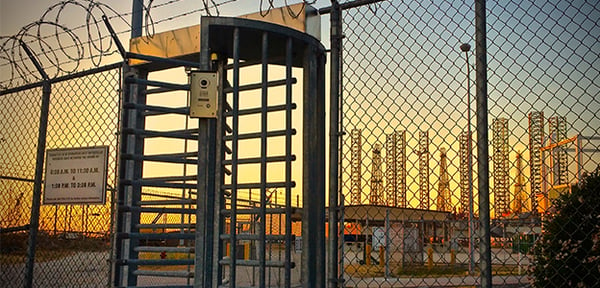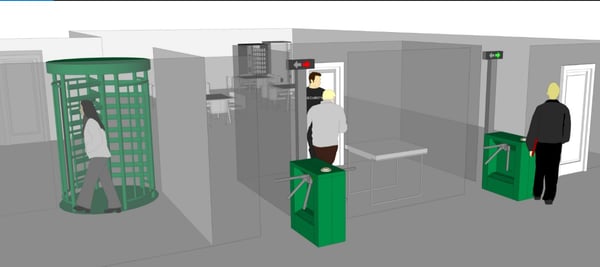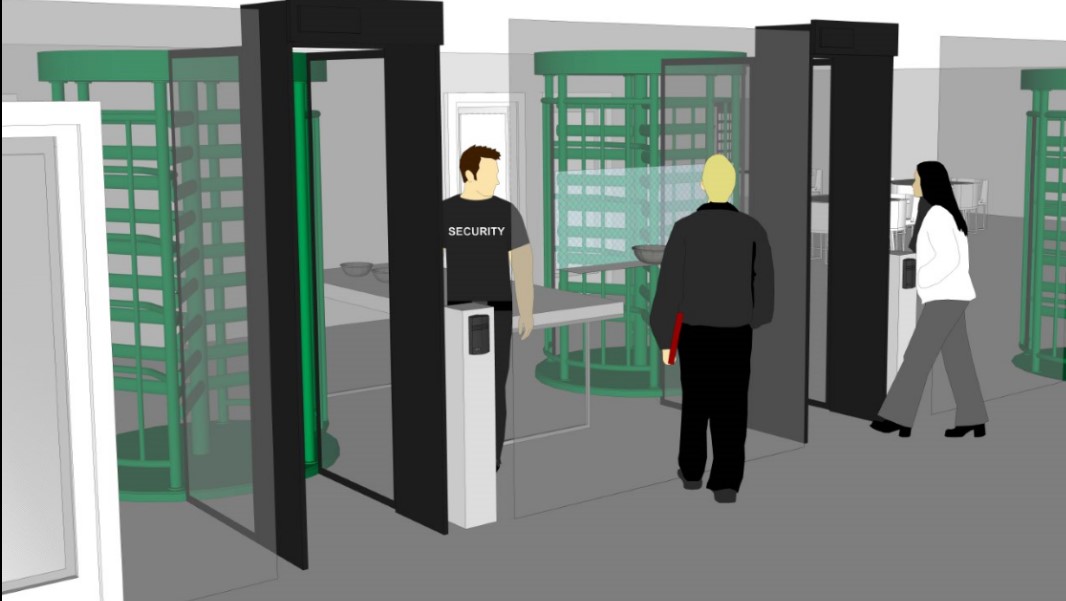By definition, distribution centers are enormous facilities, operating 24/7 and filled with millions of dollars’ worth of merchandise. They are typically on or near an airport or highway system, with a workforce that includes a high number of temporary workers to handle fluctuations in demand. Taken together, these factors can contribute to an environment with a higher level of risk.
Addressing Physical Security Risks at Distribution Centers
Security entrances are an effective mitigator to help reduce vulnerability. There are three kinds of risk that a distribution center’s physical security plan can address proactively using security entrances.
1. Theft
Lower wages and merchandise which may be high in value combine to create the pressure of temptation. The most common targets are small valuables, electronics or food that can be hidden in clothing.
2. Violence
Workplace violence often stems from the employee population. It could be domestic violence issues, such as an ex-boyfriend or husband coming into the facility, or former employees who are angry after being terminated. Beyond the violence itself, such an incident disrupts business continuity.
 3. Negative Brand Perception
3. Negative Brand Perception
When a distribution center is perceived as an unsafe place for any reason, it takes a toll on brand perception. Crime places an unwanted spotlight on the organization, whether is it a shooting, protest, or any other incident.
To effectively mitigate these risks, distribution centers can formulate a physical security plan with the following objectives:
- Prevent unauthorized individuals from entering the premises
- Reduce theft of merchandise
- Keep all weapons, including knives and guns, off the premises
- Create a safe environment and a culture of safety and security among the employee population.
A Layered Approach to Physical Security
Meeting these objectives calls for a layered program of security entrances with manpower and technology. The layers of physical security for distribution centers are as follows:
Perimeter Security
The fenceline perimeter should discourage casual infiltration from non-employees. Since higher security practices exist inside the building, the goal at the fenceline is to primarily deter and potentially respond if an incident occurs. Typically, a tall fence is deployed with guarded entrance gates for certain vehicles (security, management and freight). Cameras are used to record any activities along the fenceline that may occur so they can be reported or investigated after the fact.
If there is parking for employees outside the fenceline, full height turnstiles are placed on the fenceline so that employees can use their credentials to unlock the turnstile and enter one at a time into the secure area.
 Initial Entry, Divestment and Screening
Initial Entry, Divestment and Screening
As employees enter the building, they can divest their personal belongings, such as bags, purses, metal objects, phones, keys, etc. into lockers Then, employees approach a manned booth or window to pass any allowed metal belongings into a bowl to a guard who will give them to the employee on the secure side. To enter the secure side, employees present their credentials to the access control system, and walk through a metal detector doorway and a full height turnstile. The turnstile unlocks when the credentials are valid, however it will relock if the metal detector senses a metal object. In that case, the user must back up, remove the object (put in their locker or give to the guard) and try again. The passageway and the turnstile display a red or green light to the user, telling them if they can proceed into the facility or clear the passageway and try again.
 Employees enter a distribution center by badging credentials, passing through a metal detector, then a one-way full height turnstile. The area is manned in case of non-compliance.
Employees enter a distribution center by badging credentials, passing through a metal detector, then a one-way full height turnstile. The area is manned in case of non-compliance.
Tracking Breaks and Lunches
When employees take lunch or a break during their shift, they can proceed to a snack/concession area with seating so they can eat and relax. To enter the concession area, they pass through waist high, tripod turnstiles using their access control credentials. This setup enables data to be collected on who is on the floor or off the floor (in case of an incident) and for how long (in case of time card slippage).
End of Shift Theft Deterrence
The end of the shift is when employees are exiting the building - a prime opportunity to squelch theft. Several well-known companies are using a technique used in airports on passengers: random pat-downs or scans with a wand.
Employees must approach an array of two waist high turnstiles: one turnstile leads to an exit and the other to a search/pat down area with a guard. The employee presses a button that initiates a program that randomly turns on a green or red light. If the light is red, the “exit” turnstile remains locked and the “search” turnstile unlocks; the user must proceed through to get a pat down or scan with a wand. If the light is green, the “exit” turnstile unlocks and the employee can pass through the tripod turnstile to proceed to the exit.
All exiting employees, whether patted down or not, proceed through a final full height turnstile to exit the floor. The turnstile is configured as a one-way turnstile to prevent “backflow” into the secure area and also enable the access control system to keep track of who has left the secure area for the day in case of any incidents. The employees can then access their initial divestment area, their lockers and exit the building.
 When leaving work for the day, employees press a button and a random program indicates whether they must undergo a random pat-down search or can exit freely via one-way turnstiles.
When leaving work for the day, employees press a button and a random program indicates whether they must undergo a random pat-down search or can exit freely via one-way turnstiles.
The layered security program described in this post uses security entrances that are relatively inexpensive and ideal for deterring theft or other unwanted behaviors. If you have a big rollout at multiple locations and a limited budget, this approach can be a great fit. If you are managing a single location or can invest more up front, you can increase the ROI further by deploying a security revolving door instead of a full height turnstile. The security revolving door uses sensor technology in the ceiling to scan compartments and outright prevent attempts at tailgating or piggybacking (two people sharing a compartment together); this means you can cut down on a guard at that entrance a create a payback in less than a year.
Conclusion
One of the most important reasons that security entrances are being deployed today is to accurately control and monitor who is on the premises, along with when they entered and exited. Only security entrances can control the passage of people through mitigating tailgating or piggybacking.
While distribution centers present several significant vulnerabilities, security entrances, along with guards and technology, can work in an effective layered approach. You can leave far less to chance for error compared to using guards alone or swinging doors with access control systems You can effectively deter and control access to the secure facility, track who is in the building 24/7, and minimize theft. In the end, security entrances enable an overall physical security plan that ensures maximized safety and risk mitigation.



